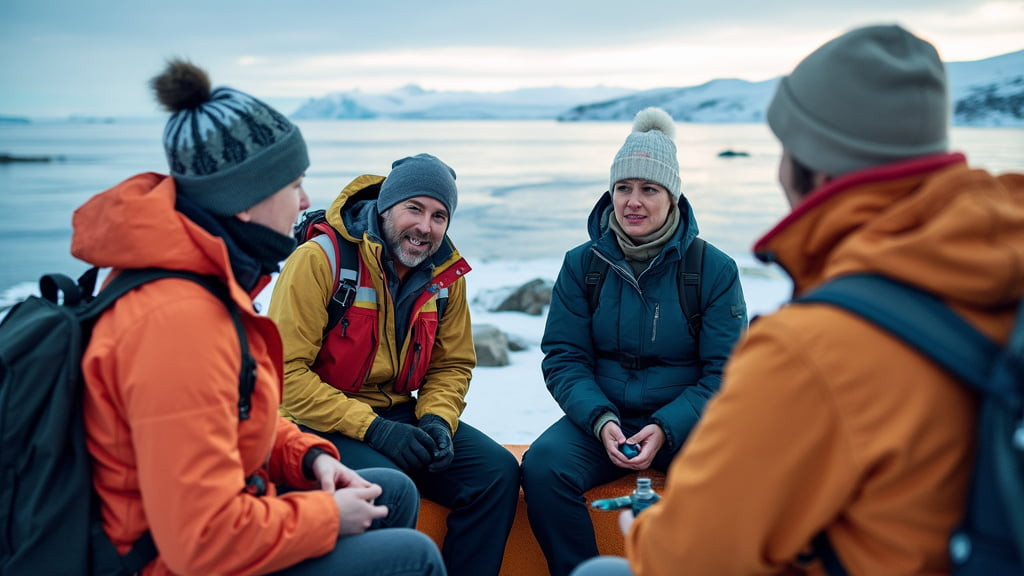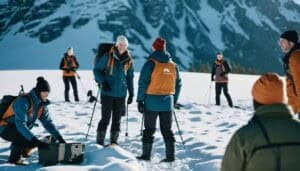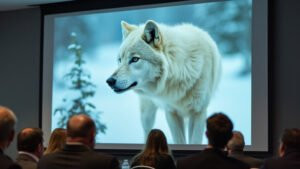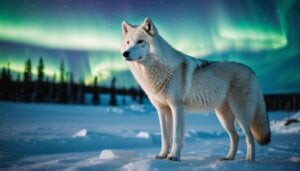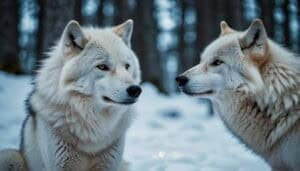Introduction
Environmental education programs play a crucial role in raising awareness about Arctic wolves, highlighting their ecological importance and the threats they face
This article explores the key components of these educational programs, the role of schools and community involvement, and the modern methods and challenges in promoting Arctic wolf conservation
By understanding how these programs operate, we can appreciate their impact on wildlife conservation and the importance of continued support and innovation in environmental education
Key Components of Environmental Education Programs Focused on Arctic Wolves
Environmental education programs designed to raise awareness about Arctic wolves encompass various components aimed at providing comprehensive and engaging learning experiences
These programs typically include curriculum development, the use of multimedia and visual aids, and opportunities for field trips and direct experiences
Curriculum Development and Integration
One of the foundational aspects of effective environmental education programs is the development and integration of a robust curriculum. This curriculum is often designed to align with existing educational standards while incorporating specific information about Arctic wolves and their habitat
For instance, teachers might develop lesson plans that cover topics such as the biology of Arctic wolves, their role in the ecosystem, and the challenges they face due to climate change and human activities. These lessons can be tailored to different grade levels, ensuring that students from elementary to high school receive age-appropriate and engaging content
According to a study published in the Journal of Environmental Education (2021), integrating wildlife conservation topics into school curricula significantly enhances students’ knowledge and attitudes towards conservation efforts
Curriculum integration also often involves interdisciplinary approaches, where Arctic wolf studies are connected with subjects like geography, ecology, and social studies. This holistic approach helps students understand the broader context of conservation issues and the interconnectedness of natural systems
Use of Multimedia and Visual Aids
Incorporating multimedia and visual aids is another critical component of environmental education programs
These tools can make learning about Arctic wolves more engaging and accessible for students. Documentaries, interactive videos, and virtual reality experiences can bring the remote Arctic environment into the classroom, allowing students to observe Arctic wolves in their natural habitat without leaving their school
For example, the use of high-quality wildlife documentaries, such as those produced by National Geographic or the BBC, can provide vivid and informative portrayals of Arctic wolves. These films often highlight the wolves’ behavior, social structure, and the challenges they face, making the information more relatable and memorable for students
A study by Educational Media International (2019) found that students who watched educational videos about wildlife showed a significant increase in their understanding and retention of the material compared to traditional lecture-based methods
Visual aids such as posters, infographics, and interactive whiteboards can also be used to present key facts and statistics about Arctic wolves. These tools help reinforce learning by providing visual representations of information, making complex concepts easier to grasp
Role of Field Trips and Direct Experiences
Field trips and direct experiences play a pivotal role in environmental education, offering students the opportunity to engage with nature firsthand. These experiences can be incredibly impactful, fostering a deeper connection with the subject matter and inspiring a lifelong commitment to conservation
Visits to wildlife sanctuaries, zoos, and nature reserves where Arctic wolves are housed can provide students with a unique opportunity to observe these animals up close
For example, the International Wolf Center in Ely, Minnesota, offers educational programs and exhibits specifically focused on Arctic wolves, allowing visitors to learn about their behavior, ecology, and conservation status. According to the center, such immersive experiences can significantly enhance public understanding and support for wolf conservation efforts
In addition to physical field trips, many programs also incorporate virtual field trips, which have become increasingly popular with the advancement of technology
Virtual reality (VR) experiences can simulate the Arctic environment, providing students with a realistic and engaging way to explore the habitat of Arctic wolves. Research published in Computers & Education (2020) indicates that VR field trips can be as effective as traditional field trips in terms of educational outcomes, while also being more accessible and cost-effective
By combining curriculum development, multimedia tools, and field experiences, environmental education programs can effectively raise awareness about Arctic wolves and inspire the next generation of conservationists
These comprehensive programs not only provide valuable knowledge but also foster a sense of responsibility and stewardship towards the environment
The Role of Schools and Community in Arctic Wolf Conservation Education
Schools and communities play a vital role in raising awareness about Arctic wolves through various educational initiatives
These efforts include incorporating Arctic wolf studies into school curricula, collaborating with environmental organizations, leveraging the expertise of guest speakers and wildlife experts, organizing community workshops and seminars, and conducting public outreach campaigns
Incorporating Arctic Wolf Studies Into Curriculum
Incorporating Arctic wolf studies into the school curriculum is a fundamental way to educate young minds about these majestic animals and their ecological significance
Educators can introduce units on Arctic wolves within broader topics such as biology, environmental science, and geography. By doing so, students can learn about the anatomy, behavior, and habitat of Arctic wolves, as well as the challenges they face due to climate change and human encroachment
For instance, lesson plans might include activities such as tracking the migratory patterns of Arctic wolves, understanding their role as apex predators in the Arctic ecosystem, and exploring the impact of global warming on their survival. Interactive activities like building food webs or simulating the hunting behaviors of wolves can help students grasp these concepts in a hands-on manner
A study in the Journal of Science Education and Technology (2020) found that integrating wildlife conservation topics into science curricula significantly boosts students’ environmental literacy and promotes positive attitudes toward conservation efforts. By fostering a deeper understanding of Arctic wolves, students are more likely to develop a sense of stewardship and advocacy for these animals
Collaborations With Environmental Organizations
Schools often partner with environmental organizations to enhance their educational programs
These collaborations can provide access to resources, expertise, and opportunities that schools might not be able to offer independently. Environmental organizations, such as the World Wildlife Fund (WWF) and the Sierra Club, often have dedicated programs and materials that focus on Arctic wolf conservation
For example, the WWF’s Arctic program includes educational resources and activities that can be used in classrooms to teach students about Arctic wildlife and the importance of conservation. These organizations also frequently offer guest speaker sessions, workshops, and interactive online platforms where students can learn from experts in the field
Partnerships with local wildlife sanctuaries and conservation centers can also provide students with unique learning experiences
For instance, schools might organize field trips to these centers where students can observe Arctic wolves and participate in educational programs. According to a report by the Environmental Education Research journal (2019), such partnerships enhance students’ learning experiences and foster a greater connection to wildlife conservation
Impact of Guest Speakers and Wildlife Experts
Inviting guest speakers and wildlife experts to schools is another effective method to raise awareness about Arctic wolves. These individuals can provide firsthand accounts of their experiences working with Arctic wolves and offer valuable insights into their behavior, ecology, and conservation needs
Guest speakers might include biologists, conservationists, and researchers who have studied Arctic wolves in the wild
Their presentations can cover a wide range of topics, from the daily life of Arctic wolves to the challenges of conducting field research in harsh Arctic conditions. Such talks can inspire students and provide them with a deeper understanding of the scientific and conservation work involved in protecting Arctic wolves
For example, a guest speaker from a local university or conservation organization might share their experiences tracking and studying Arctic wolves, illustrating their points with photographs, videos, and field data
A study published in the Journal of Environmental Psychology (2020) found that interactions with knowledgeable and passionate speakers significantly increase students’ interest and engagement in environmental topics
Community Workshops and Seminars
Community workshops and seminars are effective tools for educating the broader public about Arctic wolves and their conservation. These events can be organized by schools, local government agencies, or environmental organizations and are often open to people of all ages
Workshops might include activities such as presentations, interactive discussions, and hands-on projects related to Arctic wolf conservation
Seminars could feature panels of experts discussing various aspects of Arctic wolf ecology and conservation strategies. These events provide opportunities for community members to learn, ask questions, and get involved in conservation efforts
For example, a local community center might host a seminar series on Arctic wildlife, with a session specifically dedicated to Arctic wolves. Participants could learn about the wolves’ role in the ecosystem, current threats to their survival, and ways they can support conservation efforts
Research in the Journal of Community Engagement and Scholarship (2021) indicates that such community-based educational initiatives are highly effective in raising awareness and promoting pro-environmental behavior
Public Outreach and Awareness Campaigns
Public outreach and awareness campaigns are essential for reaching a wider audience and generating support for Arctic wolf conservation. These campaigns can take various forms, including social media initiatives, public service announcements, educational websites, and informational brochures
Social media platforms, in particular, are powerful tools for disseminating information and engaging the public. Conservation organizations and schools can use platforms like Facebook, Instagram, and Twitter to share facts, stories, and updates about Arctic wolves. Interactive campaigns, such as photo contests or virtual Q&A sessions with experts, can further engage the public and raise awareness
Educational websites and online portals dedicated to Arctic wolf conservation can provide in-depth information and resources for students, educators, and the general public. These sites might include articles, videos, lesson plans, and links to further reading and resources
Public service announcements and informational brochures distributed through community centers, libraries, and schools can also help spread awareness
According to a study in the Journal of Environmental Communication (2020), well-designed public outreach campaigns can significantly increase public knowledge and support for conservation initiatives
By leveraging the resources and expertise of schools, environmental organizations, and the community, environmental education programs can effectively raise awareness about Arctic wolves and inspire collective action towards their conservation
Modern Methods and Challenges in Raising Awareness About Arctic Wolves
Environmental education programs are continually evolving to incorporate modern methods and tackle the challenges associated with raising awareness about Arctic wolves
These methods include online courses, virtual learning platforms, addressing common misconceptions, overcoming logistical and financial barriers, and enhancing engagement through interactive methods
Online Courses and Virtual Learning Platforms
The advent of online education and virtual learning platforms has revolutionized the way environmental education is delivered. These platforms offer flexibility and accessibility, allowing learners from various locations to participate in educational programs about Arctic wolves
Online courses can cover a wide range of topics, from the basics of Arctic wolf biology to more complex subjects such as their role in the Arctic ecosystem and the impact of climate change on their populations
For instance, massive open online courses (MOOCs) offered by universities and conservation organizations can reach thousands of learners globally. The Journal of Online Learning and Teaching (2020) highlights that online courses can effectively increase knowledge retention and foster a deeper understanding of environmental issues
Virtual learning platforms also provide interactive and immersive experiences. Virtual reality (VR) and augmented reality (AR) technologies can create simulations of Arctic environments, allowing students to explore the habitat of Arctic wolves virtually. These technologies can simulate tracking a pack of wolves, observing their hunting strategies, and understanding their interactions within the ecosystem
Research in the British Journal of Educational Technology (2021) indicates that VR and AR can significantly enhance engagement and learning outcomes in environmental education
Addressing Common Misconceptions
One of the challenges in raising awareness about Arctic wolves is addressing common misconceptions and myths. Many people have limited knowledge about Arctic wolves, and misconceptions can hinder conservation efforts
Educational programs must focus on dispelling myths and providing accurate information about Arctic wolves. For example, a common misconception is that Arctic wolves are dangerous to humans. In reality, Arctic wolves are generally elusive and avoid human contact. Highlighting scientific studies and factual information can help correct these misunderstandings
Programs can use various strategies to address misconceptions, such as incorporating myth-busting sessions into their curricula, creating informational videos, and conducting public awareness campaigns
According to a study published in the Journal of Environmental Education (2019), addressing misconceptions through targeted education can lead to a more informed and supportive public
Overcoming Logistical and Financial Barriers
Logistical and financial barriers are significant challenges in implementing effective environmental education programs. These barriers can limit the reach and impact of educational initiatives, particularly in underserved and remote communities
To overcome these challenges, organizations and schools can seek funding and support from government grants, private foundations, and corporate sponsorships
Collaborative efforts between schools, environmental organizations, and local communities can also pool resources and share costs. For example, partnerships with local businesses can provide financial support for field trips, educational materials, and guest speakers
Additionally, leveraging digital platforms can reduce costs associated with physical materials and travel. Online courses and virtual field trips can provide high-quality educational experiences without the need for significant financial investment
The Journal of Environmental Management (2021) emphasizes that innovative funding models and resource-sharing can enhance the effectiveness and reach of environmental education programs
Enhancing Engagement Through Interactive Methods
Engaging learners effectively is crucial for the success of environmental education programs. Interactive methods can significantly enhance engagement and ensure that learners are actively involved in the learning process
Hands-on activities, such as building models of Arctic wolf habitats, conducting simulated tracking exercises, and participating in conservation projects, can provide practical learning experiences. These activities help students apply their knowledge and develop a deeper understanding of the subject matter
Interactive digital tools, such as gamified learning platforms and mobile apps, can also enhance engagement. For instance, educational games that simulate the life of an Arctic wolf can teach students about the challenges these animals face in a fun and interactive way
Research in the International Journal of Educational Technology in Higher Education (2020) found that gamification and interactive tools can significantly improve motivation and learning outcomes
Furthermore, encouraging student-led projects and initiatives can foster a sense of ownership and responsibility. Projects such as creating awareness campaigns, conducting research on Arctic wolves, and presenting findings to the community can empower students to become advocates for conservation
By embracing modern methods and addressing the challenges associated with raising awareness about Arctic wolves, environmental education programs can create impactful and lasting change. These programs not only educate but also inspire individuals to take action in protecting Arctic wolves and their habitats
Conclusion
Environmental education programs play a crucial role in raising awareness about Arctic wolves and promoting their conservation
By integrating comprehensive curricula, utilizing multimedia and visual aids, and offering immersive field experiences, these programs provide students with a deep understanding of Arctic wolves and the environmental challenges they face
Schools and communities are central to these efforts, incorporating Arctic wolf studies into educational programs, partnering with environmental organizations, and organizing community workshops and seminars. Guest speakers and wildlife experts further enrich the learning experience, offering firsthand insights and inspiring future conservationists
Modern methods such as online courses and virtual learning platforms expand the reach of these programs, making them accessible to a global audience
Addressing common misconceptions, overcoming logistical and financial barriers, and enhancing engagement through interactive methods are essential to the success of these educational initiatives
Ultimately, by fostering a sense of responsibility and stewardship, environmental education programs empower individuals and communities to take action in protecting Arctic wolves and their habitats. These efforts are vital in ensuring the survival of Arctic wolves and the preservation of the delicate ecosystems they inhabit
